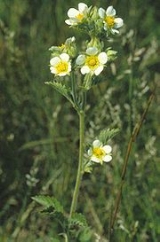
Potentilla arguta
Encyclopedia
Drymocallis arguta, commonly known as the tall cinquefoil or sticky cinquefoil, is a perennial plant
in the Rosaceae
family of flowering plants native to North America. It was formerly included with the typical cinquefoils in the genus Potentilla
.
There are two accepted subspecies
:
D. arguta is thought to be a protocarnivorous plant
. In his 1999 journal article, G.G. Spoomer tested several plants in the Pacific Northwest
for the carnivorous
syndrome, using the digestion of proteins as the diagnostic tool to determine which plants appeared to produce protease
enzymes capable of breaking down potential prey. D. arguta displayed a capability to digest and absorb the 14C-labeled algal protein placed on the sticky trichomes that the plant possesses. However, it is not known whether the digestive enzymes were produced by the plant itself or surface microbes. Additionally, some definitions of carnivory require the plant to gain some tangible benefit in capturing and digesting prey, such as increased seed yield or growth. Such an experiment has not been done with this species.
Perennial plant
A perennial plant or simply perennial is a plant that lives for more than two years. The term is often used to differentiate a plant from shorter lived annuals and biennials. The term is sometimes misused by commercial gardeners or horticulturalists to describe only herbaceous perennials...
in the Rosaceae
Rosaceae
Rosaceae are a medium-sized family of flowering plants, including about 2830 species in 95 genera. The name is derived from the type genus Rosa. Among the largest genera are Alchemilla , Sorbus , Crataegus , Cotoneaster , and Rubus...
family of flowering plants native to North America. It was formerly included with the typical cinquefoils in the genus Potentilla
Potentilla
Potentilla is the genus of typical cinquefoils, containing about 500 species of annual, biennial and perennial herbs in the rose family Rosaceae. They are generally Holarctic in distribution, though some may even be found in montane biomes of the New Guinea Highlands...
.
There are two accepted subspecies
Subspecies
Subspecies in biological classification, is either a taxonomic rank subordinate to species, ora taxonomic unit in that rank . A subspecies cannot be recognized in isolation: a species will either be recognized as having no subspecies at all or two or more, never just one...
:
- Drymocallis arguta subsp. arguta – tall cinquefoil proper
- Drymocallis arguta subsp. convallaria – cream cinquefoil
D. arguta is thought to be a protocarnivorous plant
Protocarnivorous plant
A protocarnivorous plant , according to some definitions, traps and kills insects or other animals but lacks the ability to either directly digest or absorb nutrients from its prey like a carnivorous plant...
. In his 1999 journal article, G.G. Spoomer tested several plants in the Pacific Northwest
Pacific Northwest
The Pacific Northwest is a region in northwestern North America, bounded by the Pacific Ocean to the west and, loosely, by the Rocky Mountains on the east. Definitions of the region vary and there is no commonly agreed upon boundary, even among Pacific Northwesterners. A common concept of the...
for the carnivorous
Carnivorous plant
Carnivorous plants are plants that derive some or most of their nutrients from trapping and consuming animals or protozoans, typically insects and other arthropods. Carnivorous plants appear adapted to grow in places where the soil is thin or poor in nutrients, especially nitrogen, such as acidic...
syndrome, using the digestion of proteins as the diagnostic tool to determine which plants appeared to produce protease
Protease
A protease is any enzyme that conducts proteolysis, that is, begins protein catabolism by hydrolysis of the peptide bonds that link amino acids together in the polypeptide chain forming the protein....
enzymes capable of breaking down potential prey. D. arguta displayed a capability to digest and absorb the 14C-labeled algal protein placed on the sticky trichomes that the plant possesses. However, it is not known whether the digestive enzymes were produced by the plant itself or surface microbes. Additionally, some definitions of carnivory require the plant to gain some tangible benefit in capturing and digesting prey, such as increased seed yield or growth. Such an experiment has not been done with this species.

